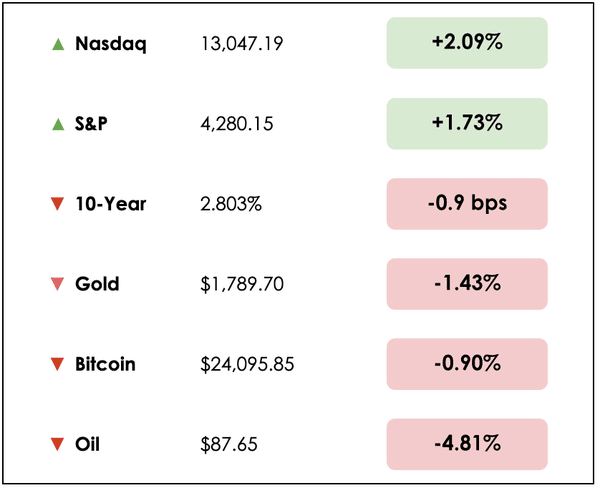False Dawn
15 August 2022

Hi, The Investor’s Podcast Network Community!
Welcome back to We Study Markets!
Mondays are tough, but they’re better with friends.
Make sure you scroll to the end of our newsletter today to find your unique referral link, just share this with friends, and as they sign-up for this newsletter, you’ll earn free stuff like access to our value investing courses, a personalized TIP-style sketch, and even a new MacBook Pro (no strings attached).
Stocks had a big Friday, though, commodities were down over the weekend following weak economic data out of China that spurred a surprise interest rate cut from the country’s central bank.
More about this in our In The News Section below.
Here’s the market rundown for today:

*Equities as of 4pm EST on prior day’s close, Bitcoin, bond, and oil prices as of this morning
Today, we’ll discuss a warning from corporate bond markets for equities, the impact of demographics on investing, China’s rate cut, and the effect of western sanctions on Russia.
All this, and more, in just 5 minutes to read.
Let’s do it! ⬇️
IN THE NEWS
😟 False Dawn for U.S. Equities? (FT)
Explained:
- Even though the S&P 500 and the Nasdaq both have notched their fourth consecutive week of gains, Paul Britton, founder of Capstone Investment Advisors, says it may be premature to start celebrating.
- Why? He says corporate debt concerns could spark another downturn at the end of this year as investors have not yet reckoned with the effects of higher interest rates on highly leveraged companies.
What to know:
- News of companies struggling to refinance their debt at affordable rates could cause nervous investors to hit the sell button. Many companies took advantage of extremely low interest rates in 2020 and 2021 to refinance their debt, but cracks are appearing in the debt markets. Higher rates may cause serious issues for highly indebted companies needing to refinance in the coming quarters.
- With the Fed seemingly intent on reducing inflation through further rate hikes, many investors question whether the U.S. rebound in stocks will continue. Britton says do not expect the Fed to ride to the rescue with lower rates for cash-strapped companies having refinancing woes.
 China’s Growth Slows Prompting Rate Cut (WSJ)
China’s Growth Slows Prompting Rate Cut (WSJ)
Explained:
- Retail sales, youth unemployment, and property prices for China all worsened in July causing the country’s central bank to cut two key interest rates. The People’s Bank of China lowered rates by 0.1 percentage points and pumped the equivalent of $59.3 billion into China’s financial system with the hopes of revving up lending and stimulating wider economic growth.
- Consumer confidence has been shaken by repeated threats of continued lockdowns, as well as a major property bust. Roughly 20% of Chinese youth are currently unemployed.
What to know:
- Chinese officials have pinned their hopes for an economic revival on heavy government spending on infrastructure, but data so far suggests the benefits have been limited.
- The breadth of economic challenges facing Xi Jinping may prove to be a thorn in his side as he seeks an unprecedented third term in power as leader of the Chinese Communist Party.
❌ Western Sanctions Have Limited Impact On Russian Oil Output (FT)
Explained:
- The International Energy Agency said on Thursday that sanctions had proven to have little effect on Russia’s oil exporting business, as the group raised its 2023 forecasts for Russian crude production.
- While Russia has lost out on exporting approximately 2.2 million barrels per day to Europe and its allies, the pariah country has rerouted much of this lost demand to China and India while benefiting from generally higher prices over the past few months.
- Production is only slightly below pre-war levels, and export revenue over the past two months alone is estimated to be $40 billion.
What to know:
- Although Russia is benefiting from a trend in higher oil prices following its invasion of Ukraine, its exports do tend to sell at a discount relative to the rest of the world given complications from sanctions.
- This discount is thought to be a primary driver for why Asian countries have been quite eager to purchase Russian oil. As time has passed, the recorded discounts on Russian crude oil have narrowed though.
- With Russia slowing natural gas flows into Europe, the continent has been forced into an energy crisis as gas prices rocket. Consequently, oil burning has become increasingly used for energy production which is expected to only drive up oil prices further given this new demand.
- Higher oil prices would, however, serve to offset revenue losses from falling natural gas sales to the EU for Russia. For now, it’s clear that sanctions are not having the desired effect, at least with respect to crippling Russia’s oil export industry.
FEATURED SPONSOR
Are you worried about inflation? There are few better ways to beat inflation than real estate, but even real estate isn’t all sunshine an rainbows. Learn about the red flags from PassiveInvesting.com.
DIVE DEEPER: DEMOGRAPHICS TRENDS — INFLATIONARY OR DEFLATIONARY?

Today’s Deep Dive is inspired by a discussion we listened to from David Stein, a past guest and friend of TIP.
He raises an interesting question that we wanted to touch on: Are current population trends set to have an inflationary or deflationary impact on the global economy?
What to know
The question seems straightforward enough, but the answer has huge ramifications for societies, governments, businesses, and investors.
According to the United Nations, there are currently 8 billion people in the world. And that number is set to grow to nearly 10 billion by 2050, but growth will peak later in 2086 at approximately 10.4 billion.
Standards of living are rising globally, which means people are living longer, experiencing lower rates of infant mortality, and generally having fewer kids than they have had historically.
This means that by the end of this century, global population growth is expected to stagnate and even begin declining.
While that sounds far away, our children and grandchildren will certainly live to see it, and since stagnation is expected to occur much sooner in developed world economies, we’ll likely not be immune from these effects either.
Impacts
If the global population peaks, or even just a given country’s population peaks, how do we reconcile this with our current consumer-based, debt-fueled, produce, produce, produce ad infinitum, economic models?
In other words, our investment plans, business goals, and even monetary system are based on consistent nominal economic growth, which is largely driven by our ability to produce and consume more collectively. This is hard to do, though, with a declining and aging population.
For example, the general premise behind our retirement systems, like social security, is that we’ll always have a growing population of young, working-aged people who can produce enough and pay into a social safety net. This dynamic enables the oldest among us to comfortably step out of the labor force while tapping into said safety net.
What if, though, the population of elderly folks exceeds or disproportionately weighs on the number of working-aged people, as is expected in Japan and elsewhere?
The system certainly strains, if not crumbles, for there are fewer and fewer workers to sustain the growing needs of retired consumers.
Countries are then forced to compete with each other for much-needed new workers through immigration. Otherwise, they risk a devastatingly uneven population distribution unable to generate the tax revenue and economic growth necessary to sustain themselves.
This is not a distant hypothetical either. For China, its population is expected to shrink by 2050; they must think through their response now.
What else to know
Banks, whose lending activities drive economic expansion, rely principally on a fractional reserve system. This means that to be profitable, they must accept your deposits as liabilities at one interest rate and then lend to businesses and other borrowers at a higher rate in loans that become assets on their balance sheets.
If, however, our population is stagnant, the need for loans premised around building new housing, constructing new restaurants, or other new businesses is drastically reduced.
There are only so many people in this reality, and without net immigration flows, there are limits to the marginal demand increases necessary to make these new expansionary projects viable.
Perhaps then, this pushes us towards disinflation or possibly deflation, as bank lending and money supply growth correspondingly slow.
For investors
A changing composition of economic activity would surely influence how we invest.
In valuing stocks, the traditional discounted cash flow model relies on projecting short-to-intermediate-term free cash flows while incorporating modest indefinite growth assumptions normally matching the status quo of 2% GDP growth.
Companies should, however, broadly expect to see their earnings stay much more constant over time in the future, rather than playing the current game on Wall Street where CEOs fixate on perpetual growth each quarter.
Instead, we’d a face a more steady-state economic environment where growth in the traditional sense is not feasible due to population constraints.
In a no-growth world, what it means then to be an equity holder in many businesses is turned upside down.
And stock returns would likely be far less than recent historical precedent, since, in aggregate, stocks would no longer be worthy of a growth premium over bonds (assuming companies’ underlying cash flows aren’t continuously increasing).
Stein likens the challenge before us as going from an economy like an airplane meant to take off and grow to a helicopter that hovers in place.
So, inflationary or deflationary?
This question boils down to how populations are distributed and how productive they are.
In a world with more elderly and unemployed consuming resources produced by an increasingly diminishing labor force, this excess demand for a limited supply is intuitively inflationary as prices are bid up.
On the other hand, maybe we should be betting on the ingenuity of mankind to sufficiently boost productivity through technological improvements, such that a declining population doesn’t wreak havoc.
Should robots and AI be able to offset much of the labor performed by humans, this would raise a whole other set of issues.
Still, it would certainly boost our capabilities to produce more supplies of goods which would be deflationary for prices.
Or maybe, we’ll just have to adjust to consuming less or consuming differently than we do now which could also be deflationary.
So let us know by hitting reply to this email, do you think we are on track for a more inflationary or deflationary world?
In this environment, would you still want to own stocks?
For more David Stein, we recommend his podcast Money for the Rest of Us, or you can listen to our most recent interview with him here.
QUOTE OF THE DAY
“Diversification is protection against ignorance. It makes very little sense if you know what you are doing.”
– Warren Buffett
How many stocks should you own in your portfolio?
The traditional advice is to spread your investments over a broad array of financial instruments, industries, and other categories to mitigate risk and reduce the volatility of your portfolio over time, per Modern Portfolio Theory at least.
Over his investment career, Warren Buffett, however, has often warned investors that diversification can be damaging to returns.
The reality is that while diversification through traditional index investing may be appropriate for many investors, others may want to have a concentrated portfolio of great businesses they truly understand.
Many legendary investors can indeed trace their roots of success back to a single investment or highly profitable business. Diversification may preserve wealth, but concentration builds it according to Buffett.
Consider Charlie Munger’s portfolio at his company, The Daily Journal Corp. 96% of the portfolio is in just three stocks – Bank of America, Wells Fargo, and Alibaba. Mohnish Pabrai is another value investor well-known for holding just a handful of great companies.
Buffett’s largest single allocation of one stock to his portfolio was in the 1950s, when he invested half his net worth in Geico. He made a quick 50% return in just a year, sold his stake, and plowed the proceeds into cheaper stocks.
Buffett has never said, though, that investors should avoid diversification entirely. He believes investors should have some, but not too much, and not if it comes at the cost of investing in things they don’t understand.
He has also said all it takes to become wealthy is “three wonderful businesses” and noted that “six wonderful businesses may be all the diversification you need.” However, his advice on diversification is worthless if not coupled with rigorous investment research.
Do you agree with the Sage of Omaha?
Is holding just three to six stocks something you are comfortable with, assuming you truly understand the companies you own?
Let us know what you think.
For building concentrated portfolios and tracking legend investor portfolios, we love to use this tool.
SEE YOU NEXT TIME!

That’s it for today on We Study Markets!
See you later and enjoy the weekend!
If you enjoyed the newsletter, keep an eye on your inbox for them on weekdays around 12 pm EST, and if you have any feedback or topics you’d like us to discuss, simply respond to this email.













